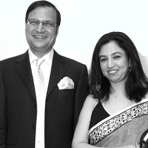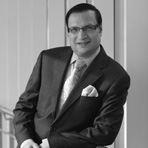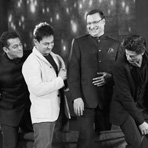My life
Date of Birth
Introduction
Rajat Sharma is best known for his show, Aap Ki Adalat, and his role as the Editor-in-Chief of India TV. On weeknights, he hosts the 9 pm Prime Time News show, Aaj Ki Baat. He has been a familiar face on TV for the last 27 years. Before joining television, he was the Editor of Onlooker, Sunday Observer and The Daily. Currently, he is Vice President, Strategic Affairs of The Indian Broadcasting Foundation.
My story
I was not born with a silver spoon. I come from an extremely humble background. I had seven siblings – six brothers and one sister, and imagine all nine of us including our parents sharing a 100 square feet room which we called home. Every day was a struggle for us. We did not have the luxury of running water or electricity! In fact, we would bathe under the municipal tap nearby and two of us would then carry a bucket of water for my mother and sister. At night when others slept, I would study under the lamp post on the Sabzi Mandi railway station. And yet, I have such fond memories of those days; despite all the hardships, life indeed was very simple.
I knew the only way to fight my poverty was to study hard and make my life worth living. And fortunately, I was good in studies. I used to study at the nearby Municipal School. Later, I joined Ramjas School in Karol Bagh and had to walk to school every day from Sabzi Mandi. I scored well enough to secure a place at SRCC. At that time, all I wanted to do was to complete my B.Com, and get a stable job in the Public Sector bank thereby guaranteeing middle class security.
There is one incident I often recall with fondness. While paying for my fees at SRCC, I was literally counting the money I had till the last coin. It was then, that a senior chanced upon me and offered help. We got talking and this formed the basis of a bond that has only strengthened over the years. And, that senior student is none other than the country’s former Finance Minister, Late Arun Jaitley. I am quite indebted to Arun for having guided me in so many ways.
Those days were quite difficult for me. Determined to finance my own studies, I took up a teaching assignment at a tutorial. Mornings and evenings were spent teaching at the tutorial, and during the day, apart from attending classes at college, I was also dabbling in student politics. Those were the turbulent 70s when we plunged into the JP Movement. I was strongly inclined towards debating. My oratory skills came very handy once when I doubled up as the warm up speaker for Jayaprakash Narayan or JP, as he was fondly called then, during one of his memorable meetings at Maurice Nagar Chowk near Delhi University.
One incident that impacted not just me but the entire country was the Emergency when all sorts of anti-establishment voices were being throttled. In June 1975 when Emergency was imposed; my colleagues, friends and I were put behind bars. I spent 11 unforgettable months in Tihar Jail. The year 1977 was a vindication of sorts for all of us; when Indira Gandhi was voted out of power. That very year at the DUSU elections, my close friend and current Rajya Sabha MP of BJP, Vijay Goel got elected as the President and I got elected as the General Secretary. Politics actually became a passion for all of us and cutting across political lines, some of us became fast friends. Arun Jaitley , Vijay Goel, Sitaram Yechury, Sharad Yadav and later Jagdish Tytler, Ghulam Nabi Azad and, Rajesh Pilot – all of us were fuelled by our penchant for politics. And I can proudly say that most of my friendships till date are more than 40 years old.
My Inspiration
I firmly believe that the trying circumstances in which I grew up played a very crucial role in shaping my outlook towards life. I dreamt big and knew the only way to overcome my poverty was to study hard, work hard, and, use it as a cornerstone to fulfil my ambitions in life. Of course my father too had an important part to play. Those were the days when television had just started making inroads and owning one was a luxury. The entire neighbourhood would flock to a particular house that had a TV. Naturally at times, the mohalla’s enthusiasm would be too much for that neighbour to handle, eventually leading to a no entry scenario. It was one such day when I was extremely dejected, and I expressed my angst to my father. It was then he remarked “instead of going to the neighbours’ to watch TV, you should do something that you appear on TV and the entire neighbourhood gets to watch you.” Those words actually left an indelible impact on my mind and that day I vowed to carve a niche for myself.
My career before India TV
Having completed my M.Com, I vigorously started scouting for jobs. That’s when I met well known seasoned journalist of those days, Mr Janardan Thakur. He had just left Ananda Bazar Patrika and was to write a syndicated column. He hired me as a researcher for his column. One day I even sought permission from him if I could utilise some of the information that I gathered while researching.
I wrote my first story for the Onlooker, a fortnightly magazine and was paid Rs300 for it. Naturally I was thrilled since this was so much more than the monthly 400/- I was getting paid in my current job. I finally joined Onlooker as a trainee reporter in the year 1982, and within 2 years I was made the Bureau Chief, and in 1985 I was made the Editor whereby I had to shift to the commercial capital of India, Mumbai – Bombay then. And all this happened when I was only 28!
It was such a heady feeling for me since I tasted success at such a young age. But success also brought along some inevitable pitfalls. Most people in the journalistic circle kept judging me by my age. There were people like Dom Moraes, Shobha De who were sceptical about my skills as an Editor (of course Shobha and I later became very good friends).
In 1988, I shifted to the Sunday Observer as the Editor and subsequently to The Daily, also as the Editor. I continued with the print medium for 10 long years. Unfortunately, none of these exist today.
1992 was the turning point in my life. I was flying back to Delhi from Mumbai when I bumped into my friend from SRCC, Gulshan Grover. He wanted to meet the Chairman of Zee Network, Mr Subhash Chandra who was also on the flight. I got Gulshan to meet Subhash Ji and we three struck up a conversation. And it was in the midst of this conversation that the idea of an interview in the format of an “adalat” was mooted. A few days later, Subhash Ji called me and wanted me to send him a detailed brief of the “adalat” kind of interview. This was unbelievable! I had never paid heed to that casual conversation but Subhash Ji clearly wasn’t casual about it. For me television was an unchartered territory and I kept procrastinating. But Subhash Ji was persistent since he had realised the potential of the show and therefore wanted me to host the show. Finally I asked a television producer friend of mine to help get me acquainted with the medium. I even served tea to the camerapersons who had no inkling that I was an Editor in print!
It was in February 1993 that the first episode was shot with Lalu Prasad Yadav as the guest and the second episode was with Khushwant Singh. This was followed by T N Seshan and Kapil Dev. The challenge was to get high profile people from different walks of life. The first episode finally went on air on March 14, 1993. The rest, of course is history. I had never imagined that this show would become so popular and make me a celebrity of sorts; from a print editor I turned into a star, could I have asked for more?
In 1995 we launched India’s first private television news bulletin. This bulletin was beamed across satellite footprints in Asia, Europe and North Africa. Two years later, my wife Ritu and I decided to set up our own production house – Independent News Service (INS). In fact, this is the parent company which owns India TV.
Journey of India TV
2004 was an important milestone in my life; that is when we decided to launch our own news channel, India TV. We wanted India TV to be seen as an idealist channel. We roped in Tarun Tejpal for investigative stories, Maneka Gandhi on issues of animal welfare and Madhu Kishwar on women’s issues. We had a dedicated segment on rural health. I received lot of accolades for the serious content of the channel. But our initial euphoria soon turned into a nightmare. Within a span of 2 years, we were bleeding heavily. Sadly, there were no takers for our channel and soon funds dried up. Our ratings were slipping and advertisers shied away from us. We were languishing at number 8. I had to sell off my property to pay for staff salaries. I was forced to even pawn my wife’s jewellery! It was perhaps the most difficult period in my life. I even got queries for a distress sale of the channel. It was sad that serious or ideal journalism wasn’t economically viable.
I had two options in front of me – either to shut shop or turn the tides of the channel. I did not want to give up so easily. Finally at a brainstorming session with the senior editorial staff, we got discussing options and that’s when we decided to focus on shows that were popular on other channels. Kaal Kapaal Mahakaal on Zee News, Khauff on Aaj Tak and Sansani on Star News were ruling the roost. That’s when we realised that the Hindi heartland was fascinated by the supernatural and crime. It set us thinking and we finally devised a new formula to stay afloat. Every hour we would have crime, bhoot, and saap. We hit the bull’s eye and within a year, our fortunes turned and we secured the 2nd spot. Soon other channels started copying us and became our clones. But Aaj Tak was still the market leader and it did have the advantage of a 6 year head start over us. That’s when I felt I must exploit my own journalistic skills. I decided to anchor a three hour bulletin from 9pm to midnight. This was early 2008 and I continued this marathon anchoring for almost a year and a half. It drained me physically but I knew the channel was dependent on me. It was a huge responsibility to shoulder. Soon we began reaping huge dividends. When there was an overall economic slowdown in the 2008-09, our revenues began to grow, astonishingly at 120%. In fact our catchy and screeching headlines soon caught the attention of others and even English channels. They too followed suit.
After making it to the top, we felt the need for some clean-up. Also, I decided to do away with the 3 hour anchoring. The channel had fought its way up and had carved its own identity. I told my team we would have to reposition ourselves and concentrate on hard news and do away with the supernatural. In 2010, we even shifted to our very own premise off the Noida Expressway. The entire transition from Film City to our current address was also an arduous task but my dedicated team made this possible seamlessly. I can proudly say we have one of the best studios in India with state-of-the-art-technology.
In December 2013, we revamped the entire look of the channel with a redesigned logo and a classier look and feel of the channel. When I look back, I often wonder if this is all a dream; I feel happy that I no longer have to make any more compromises to stay on top.
Three Images



Big Image
